Aliens: Colonial Marines Review
Anyone with half a mind for marketing would be forgiven for assuming that marrying the universe of James Cameron’s seminal sci-fi action sequel Aliens and the First Person Shooter genre would be pure gaming gold.
After all, here’s a universe ready-made for gaming, a universe that has had a huge impact on video games over the years, from Team 17 classic Alien Breed to Bungie’s Halo. Here’s a universe with the guns, guts and cojones just waiting to be moulded into the ultimate console shooter. Dark corridors, a creeping menace hounding your every step, a squad of tough hombres armed to the teeth with state-of-the-art firepower. So what is it that tends to go wrong every time? Rebellion’s recent (2010) effort Aliens vs. Predator was pretty awful, packing terrible mechanics and a terrible plot into three terrible campaigns. Rightly, people expected more when Gearbox announced that they were working on a canonical sequel to James Cameron’s hit. But does Colonial Marines stand up beside its glorious source material. Believe it or not, there’s no straight answer to that.
Colonial Marines picks up roughly seventeen weeks after Ripley, Newt, Hicks and half of android Bishop escape LV-426. A full platoon of marines aboard the US Sephora, responding to Hicks’ distress call, arrive to find the Sulaco back in orbit over the part-terraformed world, despite records (and David Fincher’s Alien 3) asserting its appearance above prison planet Fury 161. It’s this mystery that forms the basis for much of the plot: how did the Sulaco get back to LV-426 – and why?
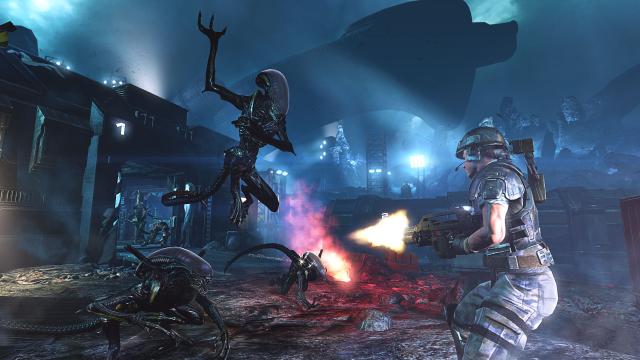
Problems are further compounded when a private military company under the employ of Weyland-Yutani shows up and starts bombarding the Sephora, eventually leading to an emergency crash-landing on the wind-blown surface of LV-426. Weyland-Yutani have established a military presence on the planet, and they’re dug-in deep.
Little noise is made about the fact that the Hadley’s Hope settlement was turned into a cloud of vapour the size of Nebraska at the end of Aliens, as in fact it seems to be almost completely intact. It’s just one in a long line of liberties taken by Gearbox during the creation of Colonial Marines, but it’s not the one that rankles the most. A late-game bastardisation of the established canon created mixed feelings as I played, to the point where I honestly felt conflicted. I’ll say no more to avoid spoilers, but you’ll know it when it comes.
But I’m ahead of myself here. You play as Corporal Chris Winter, a hardened marine who ticks all the hero-boxes. He’s honourable, courageous, chiseled, and never leaves a man behind. He’s Aaron Eckhart in Battle Los Angeles, Sam Worthington in Avatar, Dwayne Hicks by another name. The first half of the story sees Winter and his surviving crew – grizzled smart-gunner O’Neal, do-or-die CO, Cruz, and less than heroic pilot Reid – trying to find a way to rid mouthy veteran Bella of, shall we say, an unplanned pregnancy. The second half is more action-oriented, as the die-hards attempt to steal the PMC frigate and get the hell off a planet overrun with Xenomorphs.
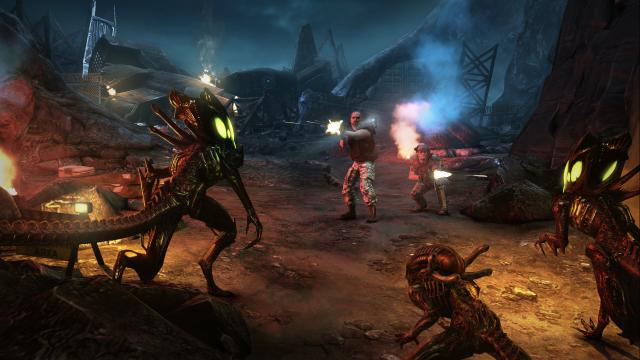
The biggest issue I have with Colonial Marines is that it still thinks it’s 1986 where the script is concerned. Films have come a long way in the last quarter-century, games far more so, and what amounts to a lot of manly posturing, air-punching and swearing doesn’t make for a great plot. That said, what this game presents as a storyline is certainly no better or worse than its source material, but it lacks the instant quotability – but then so do Gears of War or Call of Duty. People expecting Colonial Marines to have the same level of quote-tastic impact as Aliens are going to be disappointed, but it’s an unfair demand. The story is fit for purpose, and though it lacks gravitas and emotional depth, it’s an action yarn, not Shakespeare.
The visuals are another area that isn’t free from debate. On the one hand, the character models are shoddy, badly-animated and slightly odd to look at. Dead marines are recycled, so that in some rooms you feel like you’re looking at some kind of mannequin bloodbath. But on the other hand, Colonial Marines has some of the best lighting effects I’ve seen, creating deep shadows and eerie silhouettes, emulating the atmosphere of the movie to impressive effect.
Likewise, I’ve rarely seen such attention to detail, not just in the guns and armour and vehicles, but in the world itself. Gearbox deserve a great deal of credit for their interpretation of Hadley’s Hope. I got chills when I entered the MedLab to find the remains of Hudson’s wasted Facehugger, or reached Operations to see the hole in the floor that he was pulled through some time later. The colour palette, the art style, and the detail is impressive, and I felt immersed in Cameron’s world, even if at times the bugs and glitches seemed determined to pull me out. Basic issues like screen tear and texture pop-in really shouldn’t plague a game like this to the extent that they do, and bodies getting stuck through scenery or else vibrating like marbles on a tumble dryer is distracting and frustrating in equal measure.
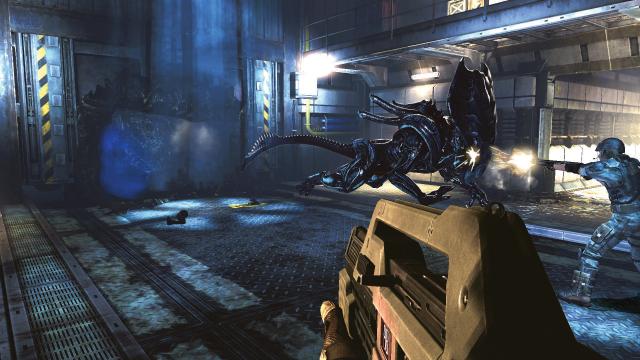
Gearbox’s obsession with iconography extends to the sound direction, too. Everything is geared towards making you feel part of that universe. The metallic, echoing grind of the M41-A Pulse Rifle, the no-nonsense chirrup of the harness-mounted smart-gun, the squeal of a spattered Xeno. Kevin Reipl’s excellent, inspired score evokes James Horner’s original work, undulating between barely-audible, nerve-strumming chords and pulse-raising runs.
It’s a shame that, while the voice actors do a good job, they’re forced to work with a poor script that lacks personality or character. Lance Henriksen returns as Bishop (a new model, confusingly referred to as “Rook” in a lot of pre-release articles), bringing a certain gravitas to proceedings, but it’s not nearly enough to make up for the rest of the two-dimensional cast. O’Neal revealing that he cares about Bella because they “uh, had a sex thing once” is as deep as it gets, but then this never was a franchise famed for its storytelling – besides Ridley Scott’s book-ending entries, of course.
As a shooter, Colonial Marines just about succeeds. The shooting is decent enough, guns are easy to aim precisely and pack enough impact – and there are certainly enough of them; a robust arsenal including pulse rifles, flamethrowers and shotguns alongside “legendary” armaments like Gorman’s service pistol or Hicks’ pump-action fill out a good-sized weapon wheel. Controlling Winter can feel a little loose at times, however, with little sense of size and weight.
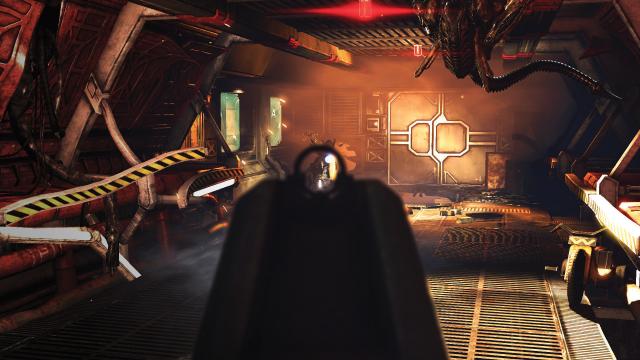
You’ll face two main enemy types throughout the campaign. The first are Wey-Yu’s mercenary squads, identikit bullet-fodder with the brains of wind-up toys whose presence lowers Colonial Marines to the levels of a Medal of Honor clone, complete with bad AI and no flanking capabilities. Gunfight areas are set up with obvious cover and little imagination, and it’s during these sections that Gearbox’s game hits its lowest points.
The other enemy is the legendary Xenomorph itself, and the biggest mistake Gearbox make – and they aren’t the first to do so – is to assume that the titular bug is the ideal enemy for an FPS. Here’s the problem: the alien itself is a creeping, stalking predator that rarely kills outright. The propagation of their species relies on taking prey alive. In the movie they stage only two all-out attacks, the first against the auto-guns, the second against the strung-out survivors. Both have a purpose, and the second sees most of the remaining cast dead, wounded or taken in minutes. Translating a creature that can go from lethal stalker to full-on zerg should be easy in a game – but it isn’t in a shooter. Instead, the Xenos drop in front of you and charge, ready to be blown away with ease. When their AI does allow them to scale walls and use the ceiling to get the drip on you, it leads to them either ineffectively slapping you or a “mash X to live” moment that rarely changes. Invincible team-mates who you can shoot through don’t help the immersion either.
Much pre-release noise was made about the motion tracker, and while its iconic, instantly recognisable beep still sends shivers up your spine, it’s largely useless in its capacity as a tracker. If an enemy is close, it will beep once to warn you, but if you want to use it as an actual tracker you need to walk around with it out (by pressing LB). Usually, by the time you pick up movement, you’ve got a handful of Xenomorphs hurtling at you anyway. Using it brings up your mission waypoints, which is handy but pointless as it’s rarely unclear where you need to go.
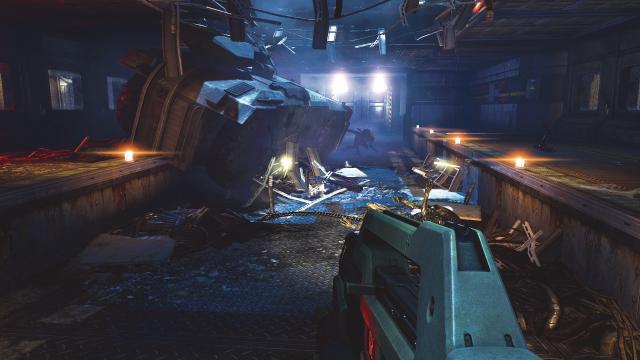
Even when you’re outside, Colonial Marines feels like a corridor shooter. You’re never challenged to use the terrain or the environment, and barely need to use your brain to get out of any situation. Two of the three “boss” fights are incredibly easy, but one is a nightmare given that the enemy AI is set to repeatedly charge you head-on. The new alien types, Boilers (who explode when startled) and Lurkers (who, well, lurk) add an element of ingenuity to proceedings but bring nothing special to the table. It’s just another example of how Gearbox have gone all out on nailing the look and sound of the universe, but completely failed to replicate the tension and complexity of the source material.
The new alien types do benefit the online modes, several of which have you playing as both customisable marines or Xenos. A few modes, such as Survivor and Escape, are built around this cross-species warfare and, despite the fact that controlling the Third-Person Xenos here isn’t much better than when we tried it in Rebellion’s game, they are good fun.
As is now standard, playing either on online or campaign grants XP and raises levels, allowing you to customise your marine and alter his loadout to suit your style. For many, the multiplayer will be the saving grace, but it’s not without its problems. One issue is that some of the maps are too claustrophobic. In the campaign it’s acceptable; in multiplayer it’s not, as you’re often stuck behind a team-mate or a piece of scenery and you get nobbled by a plucky Xeno player. There’s fun to be had online but, like the campaign (even with its drop in, drop out co-op) it’s not enough to raise your pulse.
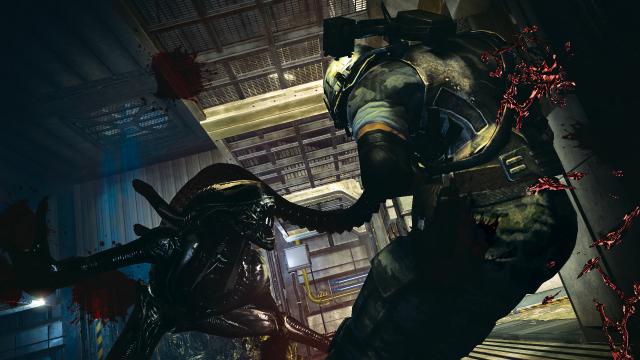
Colonial Marines took me a little over 8 hours to run through on Normal, and I had no impulse to run through it again. If you’re the sort who has to 100% every game, there are extra hours to be had in finding all the audio logs, dog tags and legendary weapons, but most will bang through the campaign in a few sittings and then play around in the multiplayer for a while.
VERDICT: A lot of people will want to hate Aliens: Colonial Marines, and Gearbox don’t do a lot to prevent that, but there are glimmers of a fine game in there. The story is hammy, but I was entertained for every minute that I played; the shooting mechanics don’t do the universe any justice, but those are the limitations imposed by the genre. That’s no excuse of course, but until someone realises that Aliens is not the perfect fit for the FPS genre that it arguably should be, this is what we’ll be stuck with.
For dedicated fans this is almost a no-brainer, and there are moments that elevate above the throwaway dross that it occasionally stoops to become. An unarmed chase through the sewers and a tense (if quite easy) climax are highlights, and the multiplayer has legs, but if you’re looking for the definitive Aliens experience, you won’t find it here. Which is a shame, because there were times when I felt genuine goosebumps as I wandered the halls of Hadley’s Hope. Ultimately, though, this really is just another bug hunt.

AVERAGE. The epitome of a 50/50 game, this title will be unspectacular but inoffensive, charmless but amiable. We aren’t condemning a game by scoring it a 5, but we certainly aren’t championing it, either.
Review code provided by publisher.




